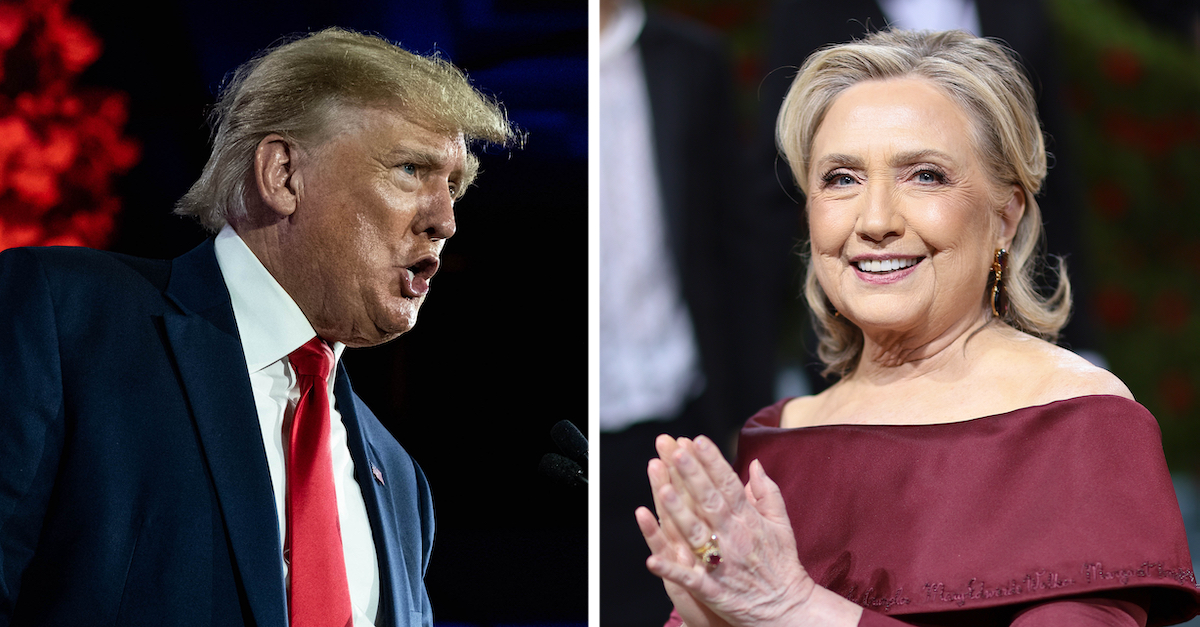
Donald Trump was photographed June 17, 2022 in Nashville; Hillary Clinton was seen May 2, 2022 in New York City.
A federal judge on Thursday declined to dismiss a sprawling RICO lawsuit filed by Donald Trump against a long list of his alleged foes — including then-rival candidate Hillary Clinton — in connection with the November 2016 presidential election.
The refusal is somewhat academic. U.S. District Judge Donald M. Middlebrooks decided that Trump’s decision to file an amended complaint on Tuesday stymied a long list of motions to dismiss filed in response to the original complaint. However, Judge Middlebrooks openly suggested that the defendants could refile their many motions to dismiss after taking into account new arguments pressed by Trump in the amended complaint.
“On June 21, 2022, Plaintiff Donald J. Trump filed an Amended Complaint,” Middlebrooks wrote. “In light of the Amended Complaint, Defendants’ currently pending Motions to Dismiss . . . are DENIED AS MOOT.”
The blanket denial involved motions to dismiss filed by Clinton; John Podesta; Fusion GPS, Glenn Simpson, and Peter Fritsch; the Democratic National Committee, DNC Services Corporation, and Debbie Wasserman Schultz; Perkins Coie LLP; Nellie Ohr; Robert E. Mook; Michael Sussmann; Marc Elias; HFACC, Inc.; Rodney Joffe; Igor Danchenko; Neustar, Inc.; Charles Halliday Dolan Jr.; and Jake Sullivan.
Those motions, when viewed from afar and boiled down to a brief summary of their contents, generally argues that Trump’s claims were barred by a statute of limitations or otherwise failed as a matter of law.
Trump’s attorneys said they would attempt to cure their case to override those arguments and made good on that promise by filing this week’s amended complaint — which remains judicially untested.
It remains to be seen whether Middlebrooks will still toss the case after another round of motions to dismiss.
“To the extent that the allegations against certain Defendants, and therefore the arguments relied on by those Defendants in support of dismissal, remain unchanged, and in the interest of reducing costs in this action, Defendants are advised that they may readopt their prior Motions to Dismiss if they so choose,” Middlebrooks wrote. “Moreover, to the extent that the various Defendants seek to raise the same arguments, they are encouraged to consolidate their responses where appropriate.”
The original motions to dismiss largely followed that paradigm; the documents generally cited one another and only expounded where necessary to elucidate a specific point as to a specific defendant.
The Trump lawsuit alleges RICO law violations, RICO conspiracy, computer fraud, and many other torts — 16 in total. It accuses the Clinton campaign apparatus and the DNC of cooking up “a nefarious scheme to discredit, delegitimize and defame” Trump; it alleges that Trump lost “in excess of twenty-four million dollars ($24,000,000)” due to the alleged acts of the various defendants.
In its original form, the lawsuit mischaracterized some of the findings of the Mueller Report. It also, in a fit of rank speculation, posited that “it seems all but certain that additional indictments are forthcoming” from Special Counsel John Durham. Durham’s prosecution of Sussmann has since ended with an acquittal, and the 2016 election date — Nov. 8 — is now more than seven months beyond the usual five-year statute of limitations for most federal crimes.
A copy of the judge’s brief refusal to dismiss the case based on the current motions is below:
[Picture of Trump by Seth Herald/Getty Images; picture of Clinton by Dimitrios Kambouris/Getty Images for The Met Museum/Vogue.]